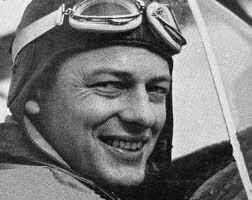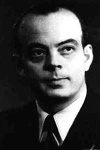Ernest K. Gann
Auteur
Activité et points forts
Thèmes principaux
Classement dans les bibliothèques
Quelques chiffres
Note moyenne : 6.67/10Nombre d'évaluations : 3
0 Citations 2 Commentaires sur ses livres
Les derniers commentaires sur ses livres

La fresque à la fois poétique et palpitante d'une époque ou le transport aérien en était encore à ses balbutiements. Des premières lignes d'American Airlines au défrichage de la liaison transatlantique pendant la guerre, l'auteur nous embarque avec lui dans des aventures aériennes et humaines dépeintes d'une plume sans égal. Le Saint Exupéry américain.
Afficher en entierLes gens aiment aussi
Dédicaces de Ernest K. Gann
et autres évènements
Aucun évènement prévu












Biographie
Ernest Kellogg Gann (October 13, 1910 - December 19, 1991) was an American aviator, author, filmmaker, sailor, fisherman and conservationist.
Born in Lincoln, Nebraska, Gann was the son of a prosperous Midwestern family. His father made his fortune as an executive with General Telephone and Telegraph in Lincoln, Nebraska; St. Paul, Minnesota; and Chicago, Illinois. Rebelling against his father's strong desire that he follow in the family telephone business, Ernest pursued several other interests as he grew up. He was fascinated by several fields including film, photography, and aviation. As a young man, he showed little interest in school and performed poorly. His parents decided that he needed discipline and that he should attend military school. He was sent to the Culver Military Academy (now Culver Academies) for his high school years. Despite many misadventures and struggles within the harsh academic environment and strict rules at Culver, he graduated in 1930. He elected to pursue filmmaking and attended the Yale School of Drama. Following his studies at Yale, Gann worked in New York City at Radio City Music Hall as a projectionist and later as a commercial movie cartoonist.
On September 18, 1933, Gann married Eleanor Helen Michaud in Chicago, Illinois. They eventually had three children; George Kellogg Gann, born November 12, 1935; Polly Wing Gann; and Steven Anthony Gann, born March 4, 1941.
A chance encounter landed Gann a job with The March of Time, a documentary film series associated with TIME magazine. In 1936, while working on the feature Inside Nazi Germany, Gann narrowly escaped Hitler’s advancing troops as they marched into the Rhineland. Returning to New York, he moved his family to a new home in Rockland County where the lure of a local airport, Christie Brothers in Congers, New York, re-kindled his interest in aviation. He purchased a half partnership in a Stinson Gull Wing airplane with actor Burgess Meredith, obtained his pilot license, and quickly became an accomplished aviator.
After earning his pilot license Gann spent his much of his free time aloft, flying for pleasure. The continuing Great Depression soon cost him his job and he was unable to find another position in the movie business. In search of work, he decided to move his family to California. Gann was able to find odd jobs at Burbank Airport, and also began to write short stories. A friend managed to get him a part-time job as a co-pilot with a local airline company and it was there that he flew his first trips as a professional aviator. In the late 1930s many airlines were hiring as many pilots as they could find; after hearing of these opportunities, Gann and his family returned to New York where he managed to get hired by American Airlines to fly the Douglas DC-2 and Douglas DC-3.
For several years Gann enjoyed flying routes in the northeast for American. In 1942, many U.S. airlines' pilots and aircraft were absorbed into the Air Transport Command of the U.S. Army Air Forces to assist in the War Effort. Gann and many of his co-workers at American volunteered to join the group. He flew DC-3s, Douglas DC-4s and Consolidated C-87 Liberator Express transports (the cargo version of the Consolidated B-24 Liberator bomber). His wartime trips took him across the North Atlantic to Europe, and then on to Africa, South America, India, and other exotic places. Some of his most harrowing experiences came while flying The Hump airlift across the Himalayas into China. In the years to come Gann's worldwide travels and various adventures would become the inspiration for many of his novels and screenplays.
At the end of World War II, the Air Transport Command released the civilian pilots and aircraft back to their airlines. Gann decided to leave American Airlines in search of new adventures. He was quickly hired as a pilot with a new company called Matson Airlines. MA was a venture of the Matson steamship line and flew from the U.S. West Coast across the Pacific to Honolulu. This experience spawned ideas that were developed into one of his best-known works, The High and the Mighty. Matson unfortunately soon fell prey to the politically well-connected Pan American Airlines and failed. After a few more short-lived flying jobs, Gann became discouraged with aviation and he turned to writing as a full-time occupation.
During his tenure with Matson, Gann and his family relocated to the San Francisco area and it was there that he began writing professionally. In his autobiography he describes cycles of "boom and bust" as he would earn seemingly vast sums of money for a book or an article, spend wildly, and then suffer through long periods with little or no income. He attempted several other lines of work--fishing, for example--but always returned to writing. Gann began to chafe under the difficult and tedious routine of family life and he found himself missing the adventures and freedoms of his previous career. His marriage began to suffer and he eventually decided to divorce Eleanor. She was afflicted with numerous health problems, including severe rheumatoid arthritis, and following several years of declining health she died on December 23, 1966 at Pebble Beach, California. Gann would endure several more tragedies in his personal life, including the death of his eldest son in 1973; while working on an oil tanker in the Gulf of Alaska, George was swept overboard in a storm.
Gann had a lifelong love of the sea and sailing. He made many friends in the nautical community in and around San Francisco and, when money was tight, tried a few different jobs- mainly in the commercial fishing industry. He owned several boats of various types and sizes during his lifetime. Eventually, after years of planning and preparations, Gann purchased a large metal sailboat in Rotterdam, Holland, which he christened Albatross. Along with his family and a few friends he sailed the boat across the Atlantic, through the Panama Canal and on to San Francisco Bay. Albatross was extensively overhauled and Gann then sailed her around the South Pacific. He later leased the ship to a film company to be used as the major prop in a movie based upon his book Twilight for the Gods. Shortly after the production wrapped, Albatross was sold and became a school vessel. She was later lost in the Gulf of Mexico. (Her sinking is the subject of a 1996 movie called White Squall.)
As his family life was deteriorating Gann began spending much of his time with a friend, Dodie Post, whom he would eventually marry. Both before and after they were married they were partners in adventure, travel, and later, environmental causes. In 1966 Ernest and Dodie purchased an 800-acre (3.2 km2) ranch on San Juan Island, Washington. This marked the beginning of his next great passion: environmental conservation. To that end, they later donated the bulk of their ranch to the San Juan Preservation Trust.
Gann converted a chicken coop near their ranch house into a writing office. After his death, the Experimental Aircraft Association (EAA) moved the entire coop and its furnishings, including the barber's chair Gann used at his desk, to the EAA Aviation Museum in Oshkosh, Wisconsin, where it is on public display.
In the fall of 1991, Gann again took to the skies to mark the 50th anniversary of his promotion to Captain at American Airlines; it would be his last flight. On December 19, 1991, Gann died in Friday Harbor, San Juan Island, Washington, at the age of 81.
Gann's describes his own writing methods as torturous, noting that he would often literally chain himself to his desk until he finished a certain amount of text. He suffered through long periods of writer's block, and frequently worried that he would run out of ideas to write about. Despite his wildly successful career, he continued to harbor strong feelings of self-doubt and often expressed surprise at the critical praise he received.
Gann's major works include the novel The High and the Mighty and his aviation focused, near-autobiography Fate Is the Hunter. Notes and short stories scribbled down during long layovers on his pioneering trips across the North Atlantic became the source for his first serious fiction novel, Island in the Sky (1944), which was inspired by an actual Arctic rescue mission. It became an immediate best-seller as did Blaze of Noon (1946), a story about early air mail operations. In 1978, he published his comprehensive autobiography, entitled A Hostage to Fortune.
Although many of his 21 best-selling novels show Gann’s devotion to aviation, others, including Twilight for the Gods, and Fiddler's Green reflect his love of the sea. His experiences as a fisherman, skipper and sailor, all contributed storylines and depth to his nautical fiction. He later wrote an autobiography of his sailing life called Song of the Sirens.
Gann wrote, or adapted from his books, the stories and screenplays for several movies and television shows. For some of these productions he also served as a consultant and technical adviser during filming. Although it received positive reviews, Gann was displeased with the film version of Fate Is the Hunter, and removed his name from the credits. (He later lamented that this decision cost him a "fortune" in royalties, as the film played repeatedly on television for years afterward.) He wrote the story for the television miniseries Masada, based on The Antagonists, and the story for the 1980 Walt Disney movie, The Last Flight of Noah's Ark.
Gann was a member or honorary member of Society of Flight Test Engineers, Order of Daedalions, Black Birds, OX-5 Aviation Pioneers, Secret Order of Quiet Birdmen, Colgate President's Club, Washington Athletic Club, Grey Eagles Club, 9th Strategic Reconnaissance Wing, Retired Eastern Pilots Association, and American Fighter Pilots Association.
Other honors included , Washington Governor Gary Locke posthumously awarded the Medal of Merit (the state’s highest honor) to Gann on July 9, 2003.
In Friday Harbor, a cafe named "Ernie's Cafe" was opened in honor of his accomplishments.
Afficher en entier